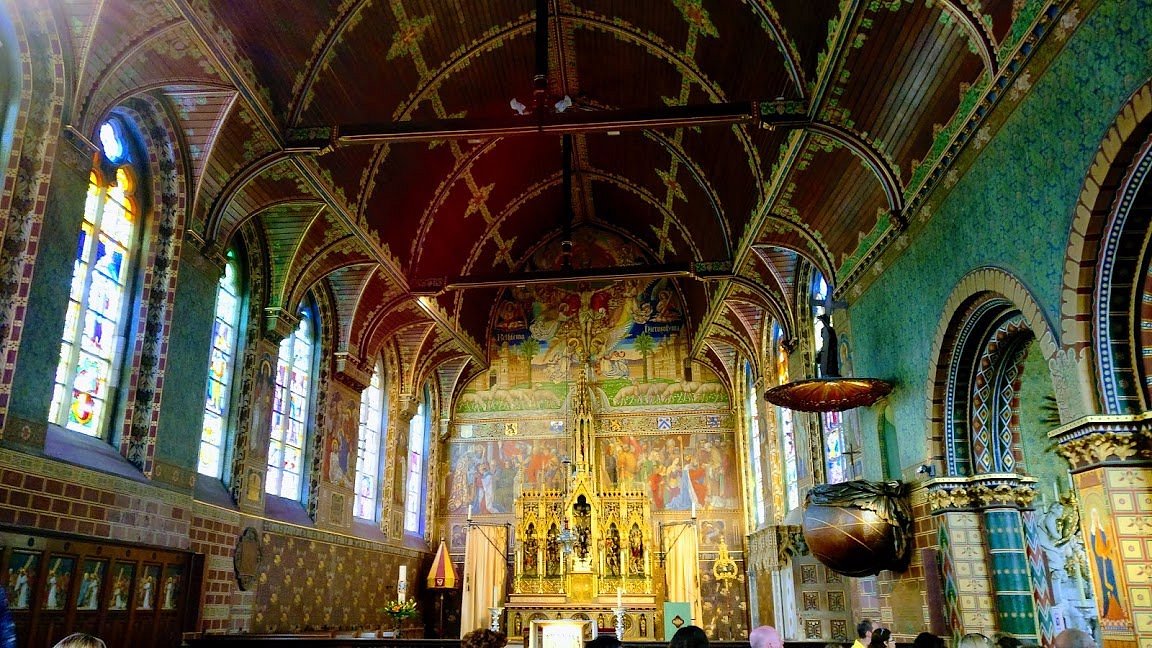History of Relic of the Holy Blood from Bruges
Today, anyone can look at the relic and touch the glass that covers it in Heilig-Bloedbasiliek in Bruges.
The phial containing blood clots is made of oriental rock crystal and dates back to the 11th or 12th century, measuring 16 centimeters in length and 2.8 centimeters in maximum thickness. It is housed in a glass container adorned with golden crowns, embellished with two angels. rame inscribed with “MCCC LXXX VIII die III maii” (May 3, 1388).
According to one legend, Joseph of Arimathea, an influential Jew and disciple of Jesus, to take care of the body of the Savior after His death. Despite protests from the other Jews, Joseph carefully cleaned the bloody wounds, hands, and feet, collecting the blood mixed with water in one vessel and the blood oozing from the wounds in another. He treasured both relics and passed them on to his descendants.
Throughout history, relics of martyrs were highly esteemed, including the Holy Blood of Jesus Christ. However, during times of religious persecution, these precious relics had to be hidden carefully. Written sources mentioning the Holy Blood were eventually found, including accounts of hermit Varipsava from the 4th century and the Panoplia Dogmatica written by Euthymius Zygaben, a Byzantine theologian, in the 8th century.
The path of the Relic to Bruges is linked to the first crusade. After the successful crusade, Gottfried of Bouillon assumed the title of Defender of Jerusalem, while other leaders of the crusade settled in cities like Antioch and Edessa. When Edessa fell to the Saracens in 1146, Thierry of Alsace, Count of Flanders, led an army to aid his son-in-law Baldwin III. Despite facing challenges and defeats during the Second Crusade, Thierry of Alsace eventually reached Jerusalem.
The traditional explanation of how the Relic of the Holy Blood reached Bruges is intertwined with Thierry’s presence in Jerusalem. While the precise details of its journey remain unclear, the Relic eventually found its way to Bruges, where it became an object of great veneration and devotion.
However, before 1256, no mention of the relic was found in Bruges. Even in the act on the founding of the Chapel of St. Basil in 1189, compiled by Thierry’s son, Philip of Alsace, there is no mention of the relic of the Holy Blood. Based on this information, we can conclude that the relic was not yet in Bruges at that time.
While the chronicles focus on the discovery of other relics in the East, such as parts of the Cross, the only indication that the relic was in Bruges comes from the 1150 list of relics held by the British Library. It notes that the relic was kept in the imperial palace in Constantinople, suggesting that it was brought to Bruges no earlier than the 13th century.
Presumably, after the capture of Constantinople in 1204, Baldwin X gave the relic of the Holy Blood, along with other relics, to his daughter Joan, Countess of Flanders. Subsequently, Jeanne donated the relic of the Holy Blood to the city of Bruges.
While this explanation seems plausible, concrete evidence is scarce. The earliest recorded mention of the relic in Bruges is found in a legal document from 1270, describing a 1256 case in which the defendant unsuccessfully requested to swear his innocence over the relic of the Holy Blood.
Moreover, it is known that the procession with the relic of the Holy Blood took place even before 1291, as documented in the Charter of the gatekeepers, which stipulates an annual procession on May 3rd.
Another significant document is a charter issued by King Philip VI of France in 1297 in the province of West Flanders Ingelmunster. In this charter, the king pledged to protect the relic in the event of an attack on Bruges.
In the papal bull Licet of June 1, 1310, Clement V granted indulgence to all participants in the procession and confirmed that at noon every Friday, a few drops of blood fell from the clots of Holy Blood.
Since then, the phenomenon of the transition of blood into its liquid state was no longer observed, except in 1388 when Bishop Urban VI placed the crystal phial in a new cylinder-shaped box in a gold frame.
To date, two versions exist regarding how the relic ended up in Bruges. The first is based on old traditions of oral history, recorded in writing in 1380. The second is the result of historical analysis of documents. As for the origin of the relic, many questions remain regarding the existence of historical evidence of its authenticity.
However, it is crucial to remember the most important aspect of this relic – that it has served as a symbol of Christ’s sacrifice for centuries, bringing joy and peace to millions of believers. This fact alone highlights the importance of the relic and its significance in the lives of people, surpassing the meticulous process of searching for its exact origin.
NOBLE BROTHERHOOD OF THE HOLY BLOOD
Since the 15th century, the Noble Brotherhood has been guarding the relic of the Holy Blood. Consisting of thirty individuals under the leadership of the dean, they are dedicated to protecting the shrine and promoting its veneration among the faithful. They organize services in honor of the relic and conduct an annual procession through the streets of Bruges.
The members of the Noble Brotherhood wear a solemn attire comprising a black dress and a red cape with the image of a pelican. The dean, as a symbol of his position, adorns himself with large gilded silver chains.
Another brotherhood, the Pious Brotherhood, also shares spiritual responsibilities and guards the relic of the Holy Blood.
Writer Rovendo
Original content license agreement Creative Commons Attribution 4.0 license









